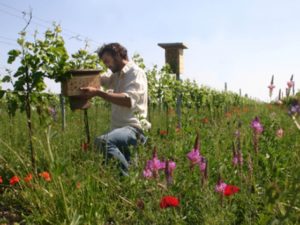Biodynamic Research
Biodynamic research is research into the Biodynamic method of agriculture. Motivated to improve Biodynamic agriculture and deepen the understanding of it, independent research facilities emerged decades ago e.g. in 1950, the Institute for Biodynamic Research in Germany (www.forschungsring.de) was founded. They were at the same time, the first research institutions of organic farming. In some European countries there are now institutions which deal partly or mainly with Biodynamic research (see attached list). The international contact for Biodynamic research programs is the Agricultural Section at the Goetheanum.
Biodynamic research covers all major areas of the agricultural sciences, where many issues of significance not only for Biodynamic agriculture, but also for organic farming in general are being studied e.g. soil fertility, food quality and plant breeding. In addition, there is research focus naturally on the Biodynamic preparations. Primarily, the classical scientific method of investigation is used.
Biodynamic agriculture is based on a broader understanding of the human being, plant, animal, earth and cosmos. It is therefore closely connected with the development of research methods that seek to understand human nature in a holistic way.
A hallmark of these research approaches is to give serious recognition to the holistic human being and how consciousness is accessed. This is associated with the appreciation of ones own senses. Knowledge will not result from a rapid integration of the facts into an existing paradigm (like materialism). An unbiased, i.e. model-free, consideration of phenomena will create the possibility to learn new things and unexpected facts about the particular object of study.
Goethe in his natural science investigations established this method. Rudolf Steiner developed the approach further, naming it accordingly ‘Goetheanism’. One of the resulting applications is the Goethean observation of plants – plants are seen in a time continuum allowing statements to be made about for instance harmony in their development (www.anthrobotanik.eu). The phenomenological observation of life leads to an appreciation of the manifestations of the life of plants, animals, etc. in their rhythms, transformations and relationships with nature and the cosmos. It provides guidance for a broader understanding of living things and their context.
Research on Biodynamic quality means studying maturity, aging, organ formation (e.g. seed, fruit, leaf) or light and shade effects since these are seen as being just as important for the evaluation of food as an analysis of their nutritive components.
Central to the indirect perception of such effects in foods are the so-called picture-forming methods such as copper chloride crystallization and paper chromatography. These are imaging techniques which use the sensitivity of certain metal salts to respond to the addition of small quantities of organic matter in solution by generating specific forms and colours. The two methods have been scientifically validated in recent years at the University of Kassel. (Webmaster: All of the following documents are in German.)
www.uni-kassel.de/agrar/nue/documents/20110727zalecka.pdf
www.uni-kassel.de/agrar/nue/documents/20110727busscher.pdf
A number of scientific papers on the methods are available. Copper chloride crystallization and chromatography are used at the Forschungsring e.V. amongst other research stations in Germany for the development of quality in Biodynamic products.
The holistic understanding of humans also causes observations to be taken seriously, which can not be classified using the senses because they are of a soul-spiritual nature. Out of a training in observation of the self and the natural world, a method has emerged to detect forces that constitute the living and lead to their sensory perception. This so-called formative forces research initiated by D. Schmidt has become an element of Biodynamic research into quality in recent years.
www.geistesleben.de/buecher/9783772514814/lebenskraefte-bildekraefte
Using it, the effects of food on the human body and life forces can be closely monitored and characterised.
Although Biodynamic research is based on high ideals, it is not unworldly; it is aimed at solving fundamental and current issues. Some examples are:
- Climate change is exposing our crops to increasing weather fluctuations. The greater root penetration proven to be found in Biodynamic farming offers a strategy to reduce the problem (see Raupp et al., 2006).
- What aspects of genetic interventions produce unintended effects on plants? An exact description of plant morphology over time proves that significant unintended effects not picked up by usual gene analysis evaluation are present.
Richter R, Damme J v, J Wirz 2011: Unintended phenotypic effects of single gene insertions in potatoes – assessing development dynamics and leaf morphology. Elemente der Naturwissenschaft 95, 9-24.) - Which agricultural method leads to the largest content of high value nutritive components? In several studies Biodynamic farming has shown higher levels than conventional or organic farming. (See Heimler et al, 2011).
- Is the effect food has on man described completely by its constituent parts and taste? Food has an emotional component quite apart from the pleasure it provides. Using enhanced sensory testing these effects become scientifically measurable.Geier U, Hermann I, Mittag K, Buchecker K. 2012: First steps in the development of a psychological test on the effects of food on the mental well-being. J Agric Sci, accepted.
II Selected research results (from 2000 on)
Soil and Compost:
- Review: Some case studies show the benefits of Biodynamic practices regarding soil fertility parameters.
Turinek M., S. Grobelnik-Mlakar, M. and F. Bavec Bavec 2009: Biodynamic agriculture research progress and priorities. Renewable Agriculture and Food Systems: 24 (2), 146-154
- Long term trial: higher organic carbon contents, better rooting (Higher density of roots on plots treated with preparations BD)
Raupp, J., Oltmanns, M. (2006): Soil properties, crop yield and quality with farmyard manure with and without biodynamic preparations and with inorganic fertilizers. In: Raupp, J., Pekrun, C., Oltmanns, M., Köpke, U. (Eds.), Long-term Field Experiments in Organic Farming. ISOFAR Scientific Series 1, Verlag Dr. Köster, Berlin, 135-155
- Higher levels of microorganisms through preparation use
Ngosong, C., Jarosch, M., Raupp, J., Neumann, E., Ruess, L. (2010): The impact of farming practices on soil microorganisms and Arbuscular mycorrhiza fungi: Crop type versus long-term mineral and organic fertilisation. Applied Soil Ecology 46, 134-142
- Long term experiment: Biodynamic management leads to advantages in soil aggregate stability, soil pH, humus formation, soil calcium, soil faunal biomass and biomass (earthworms and arthropods) even compared to s.organic system
Mäder, P., Fließbach, A., Dubois D., Gunst, L., Fried, P., and Niggli, U. 2002. Soil fertility and biodiversity in organic farming. Science 296:1694-1697.
Fließbach, A., Oberholzer HR, Gunst, L., and Mäder, P. 2007 Soil organic matter and biological soil quality indicators after 21 years of organic and conventional farming. In Agriculture, Ecosystems and Environment 118:273-284.
- Preparations improve the quality of compost and fertilizer to increase efficiency of manuring.
Jennifer R. Reeve et al. 2010: Influence of biodynamic preparations on compost development and resultant compost extracts on wheat seedling growth, Bioresource Technology, Volume 101, Issue 14, July 2010, Pages 5658-5666, ISBN 0960-8524, 10.1016/j.biotech.2010.01.144.
Plants
- Multi-year field experiment with wine: The BD preparations applied in the years 2001 to 2003 resulted in a more favourable ratio of leaf to vine growth. In one year (2003) the BD grapes had a significantly higher Brix value and tended to have higher phenolic and anthocyanin contents.
Reeve JR, Carpenter-Boggs L, Reganold JP, York AL, McGourty G, McGlosky LP 2005: Soil and wine grapes in biodynamically and organically managed vineyards. Am. J. Enol. Vitic. 56:4.
- Long term study at Geisenheim College, Germany. Ten blind samples from five farming methods could be correctly assigned with 3 picture forming methods with 100% accuracy. The two variants using both BD spray preparations (horn manure and horn silica) led to a higher yields and better material maturity than the organically managed plots.
Fritz J, Meissner G, Athmann M, Köpke U. 2009: Investigation of grape juice with the three image-forming methods: copper chloride crystallization, vertical paper chromatography and Round filter paper chromatography. In Mayer et al. Contributions to the 10th Scientific Conference on Organic Agriculture. Vlg Dr Köster Berlin
- High levels of secondary constituents in lettuce from Biodynamic farming using BD preparations.
Heimler D, Vignolini P, Arfaioli, Isolani L, Romania A. 2011: Conventional, organic and Biodynamic farming: differences in polyphenol content and antioxidant activity of Batavia lettuce. J Agric Sci 2011; 91:0.
Animals
- Biodynamic farming increases the content of valuable fatty acids in cow’s milk compared to conventional management at similar feeding intensity.
Baars T, Kusche D, Wohlers J, MOSLER S. 2011: Biodynamic Milk quality. Lebender Erde 1/2011, pp. 42-45.
- The use of biodynamic milk in nursing mothers leads to the highest levels of valuable fatty acids in breast milk.
Simoes-Wüst AP, Rist L, Mueller A, Huber M, Steinhart H, Thijs C. 2011: Consumption of dairy products of Biodynamic origin is correlated with increased contents of rumenic and trans-vaccenic acid in the breast milk of lactating women. Org Agr. DOI 10.1007/s13165-011-0013-4.
Other effects of the preparations
- In wheat, the use of the BD preparations leads to a normalized (equalizing) effect in terms of morphology and nutrient uptake of wheat.
Hagel I, Haneklaus S, Schnug E, Spieß H. 2002: Mineral content and gluten stability of winter wheat related to variety and use of the Biodynamic silica preparation. Dt. Ges. Qualitätsforschung, 37th lecture series, Hannover, pp. 75-80
Spieß H. 2002: The importance of the BD preparations in the optimization of field measures and plant husbandry. IBDF e.V., Darmstadt, Series 16, pp. 51-59
- In a field trial looking at three parameters (Fritz and Köpke, 2005), beans were tested under varying levels of light and manure and with varying horn silica application dates. The germination characteristics of the harvested seeds from the field trials were tested under uniform conditions. The germination percentage of the seedlings was increased by horn silica applications compared to the control in one of the three experimental years. The result had a high level of significance.Fritz, J.; KÖPKE, U. (2005): Effects of light, fertilizer and the Biodynamic spray, horn silica preparation on the germination characteristics of bush beans (Phaseolus vulgaris L var nanus) from the next harvest. Mitt Total Crop Science 9, 55-60
(This post is from the Demeter International website https://www.demeter.net/biodynamic-research)

